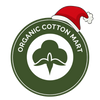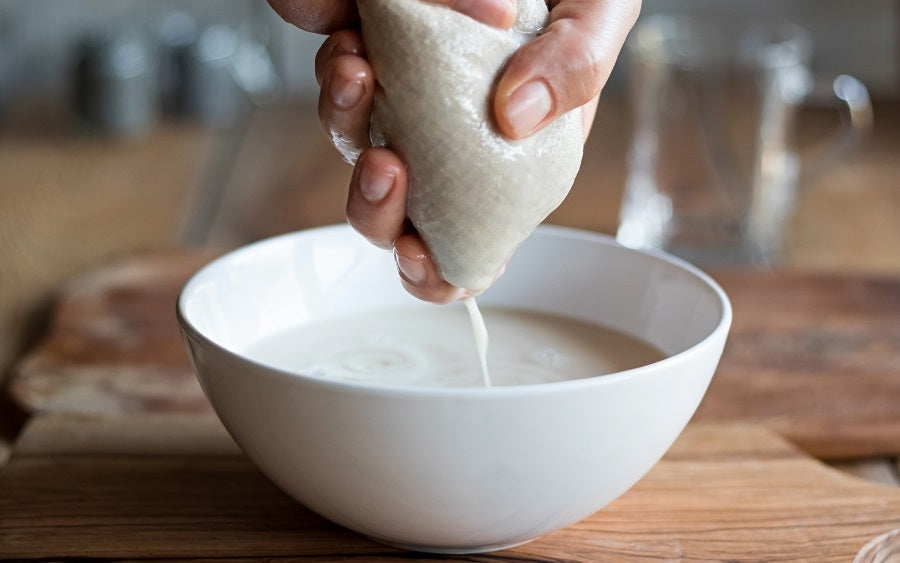Nut milk is not only utterly delish but every ounce packs in at least as much (if not more) nutrition than dairy. It’s also easier to digest than cow’s milk.
That said, a store-bought carton of nut milk every day can mess up your monthly grocery bill. Thankfully, you only need to grab a few of these ultra-useful bags to make a homemade batch of plant-based milk.
Here’s a complete round-up on nut milk bags - their uses, substitutes, and more. Read on to learn more about this helpful kitchen tool.
Table of Contents
- What is a Nut Milk Bag?
- What is a Nut Milk Bag Made of?
- Nut Milk Bag Uses: 10 Best Ways to Use These Bags in Everyday Life
- 1. To Make Plant-Based Milk
- 2. As a Cheesemaking Tool
- 3. To Store Herbs
- 4. As an Eco-Friendly Tea Bags
- 5. To Make Baby Food
- 6. As a Cleaning Cloth
- 7. For Your Juicing Needs
- 8. As a Food and Drinks Cover
- 9. As a Sprouting Bag
- 10. For Brewing Coffee
- Substitutes of Nut Milk Bags
- Nut Milk Bag Vs Cheesecloth
- How to Clean Nut Milk Bag
- Where to Buy Nut Milk Bag
What is a Nut Milk Bag?
A nut milk bag works like a strainer. The tiny holes in the bag hold back the pulp (pulverized nuts) while letting the liquid (milk) pass through. A pouch-like construction with a drawstring closure makes it easier to squeeze out milk than with cheesecloth or muslin.
If you’re a minimalist and prefer stocking items with multiple uses, the good news is that these washable and reusable nut milk bags can do a lot more than help with plant-based drinks. But first, glance through the types of nut milk bags you’ll find in the market.
What is a Nut Milk Bag Made of?
Nut milk bags are either made from an ultra-fine cotton weave or nylon mesh. Want to know which type we prefer more?
-
Food-Grade Nylon: The thing about food-grade nylon is that it doesn’t contain BPA like many other plastics. But it’s still synthetic. These bags are durable, easy to clean, and hold their shape well. However, if you’ll be using your nut milk bags to brew hot beverages like coffee and tea, it’s best to go for natural materials like cotton.
- Cotton: Cotton nut milk bags are soft, biodegradable, and durable. You can make your choice greener and more sustainable by opting for bags made from certified organic cotton because of the less water-intensive way this variety is grown. Also, the fact that organic cotton is never exposed to any form of chemicals, bleach, or pesticide makes them super safe to use around food.
Nut Milk Bag Uses: 10 Best Ways to Use These Bags in Everyday Life
If you think all these bags can do is help with DIY plant-based milk, then you’re in for a surprise! Here’s why we love these incredibly versatile kitchen helpers.
1. To Make Plant-Based Milk
Making almond milk, cashew milk, coconut milk, or whatever plant-based milk you prefer was never easier than with these bags!
All you need to do is rinse and soak the nuts in water to soften them. Next, blend them in a high-speed blender to make a slurry. Now, open the bag, secure the lining along the container’s rim, and pour the mixture slowly.
Use the drawstrings to close the bag, squeeze with all your might, and watch the smooth and creamy milk come out of the bag. Yum!
2. As a Cheesemaking Tool
Nut milk bags double up nicely as makeshift cheesecloth. The fine weave catches the solid bits and lets the liquid pass through.
Besides homemade ricotta and farmer’s cheese, you can use these bags to make ricotta, yogurt, strain soups, and stocks - pretty much everything that cheesecloth can do.
Related Article: Comprehensive Guide on What is Cheesecloth
3. To Store Herbs
A bouquet garni is an array of aromatic herbs like parsley, thyme, and bay leaves tied together into a small bundle for infusing flavor into soups and broths.
Typically, a cheesecloth is used to wrap a bouquet garni, but a nut milk bag is just as good or even better- it’s easier to pull these bags out of simmering stocks than a ball of cheesecloth.
4. As an Eco-Friendly Tea Bags
It’s time to ditch single-use tea bags and use reusable muslin tea bags. How? Just throw in some loose-leaf tea into the bag, pour boiling water over it, and strain.
What’s great is that, unlike regular tea bags, nut milk bags can be washed easily and reused.
5. To Make Baby Food
Yes, that’s right - perhaps the most hassle-free way to make baby food is by using a filtration bag. Use the wider opening of a nut milk bag to pour the puréed veggies or fruits. It removes the coarse bits and annoying fibers and smoothens the purée.
6. As a Cleaning Cloth
Like cheesecloth or muslin, nut milk bags made from woven cotton can be used as a cleaning cloth. And why not! It’s washable, easy to clean, and quick drying. Use it to dust or wipe the grime off your kitchen counter - you won’t be disappointed!
7. For Your Juicing Needs
No juicer? No problem!
Use nut milk bags to make a fresh glass of green juice whenever you crave some. Blitz the fruits, leafy greens, and/or veggies in a blender or food processor and strain the mixture through a nut milk bag. Easy-peasy!
8. As a Food and Drinks Cover
If you’re venturing outdoors, carry a couple of these bags to keep flies and creepy crawlies away from your food. The fine nylon mesh or cotton weave helps in blocking insects. Cover the containers with the bag and secure them by pulling the drawstrings or with a rubber band.
Related article: 15 creative kitchen towel holder ideas to showing off your kitchen with flair!
9. As a Sprouting Bag
One of the most popular uses of nut milk bags besides extracting vegan milk is sprouting.
Place the nuts, grains, seeds, lentils, etc., in the bag and soak it in water overnight.
The following day, drain the bag and use its drawstrings to hang it over a bowl.
Make sure you rinse it at least once every day with fresh water.
In a few days, the ingredients you’d picked will begin sprouting.
10. For Brewing Coffee
Not just tea. You can use nut milk bags for coffee filters to brew a fresh cuppa every morning. Put ground coffee in the bag and place it over a jar or a bottle. All that’s left to do now is to pour boiling water and strain.
Substitutes of Nut Milk Bags
You’ll see the fine weave or mesh design of a nut milk bag in many eco-friendly kitchen products. That’s not to say that these alternatives work just as well as a nut milk bag, but many of them come pretty close.
Here are our top picks for a nut milk bag substitute:
-
Cheesecloth: Thin and delicate cheesecloth is made from pure cotton and is porous enough to strain proteins from dairy. This fine filter quality makes it an excellent nut milk bag substitute. However, it’s not as easy to clean and doesn’t come with a convenient drawstring closure as in the case of a nut milk bag.
-
Kitchen Towel: You may use the thinnest kitchen towels, such as tea towels or flour sack towels, that you own to squeeze the milk from the nuts. Dampen the towel and place the nutty pulp on it. Now twist it with all your strength to wring out the milk.
-
Muslin Cloth: Soft and finely woven muslin is just as versatile as a nut milk bag. The small holes in this gauzy plant-based fabric won’t let fibers and chunky bits pass while being big enough to allow the liquid to seep through.
- Coffee Filter: Making nut milk using a coffee filter is a tad more time-consuming than the other substitutes we just talked about. Use it if you have no better alternative and have to make only a small batch.
Nut Milk Bag Vs Cheesecloth
It’s not uncommon to confuse cheesecloth with cotton nut milk bags. Though both kitchen tools are non-toxic, reusable, and practical, they do differ in some aspects.
-
Material - Cheesecloth is almost always made from cotton, while common materials for nut milk bags are cotton and food-grade nylon. Not only that - Nut milk bags have a tighter weave and are made from a stronger fabric. The result is smooth, silky, creamy milk without a speck, chunk, or fiber floating in it.
-
Design - Cheesecloth is a plain open-weave fabric that generally doesn’t come with a closure system, unlike nut milk bags.
- Care - Nut milk bags are easier to clean than cheesecloth. Just wash them by hand or in a washer and use the drawstrings to hang-dry them.
For the most part, it’s okay to use nut milk bags and reusable cheesecloth interchangeably. However, for hassle-free homemade plant-based milk, rely only on nut milk bags. The looser weave of cheesecloth may allow small bits of nuts or fiber to escape into the milk.
How to Clean Nut Milk Bag
The first thing you need to remember is not to let the nut milk bag sit after you’ve used it, and clean it immediately. Follow these tips to make the bags hygienic and squeaky clean.
- After emptying the contents of the bag (nut pulp), turn the bag inside out. It’s a good hack to access all seams and corners during the wash.
- The quickest way to wash these bags is to place them under running water and apply soap. The thrust from the water will wash away all the particles. You can also toss them in the washer with mild detergent.
- Hang the bags to dry using their drawstrings.
- It’s a good idea to sanitize the bags every few uses to get rid of stains and smells. You can boil them in water or soak them in a mixture of salt and water for half an hour. This trick also keeps mold and bacteria at bay.
Where to Buy Nut Milk Bag
While you can find these bags in supermarkets or grocery stores, they are much easier to find in online stores. Here, you’ll find a wider array of shapes, sizes, quality, and prices.
As always, we recommend nut milk bags made from certified organic cotton for an eco-conscious and sustainable lifestyle.


4 comments
I want things that are made in the USA? And sourced if possible?
Very helpful in my search for the most eco-friendly nut milk bag! No point in making plant milk with a wasteful, synthetic bag ;)
Great article. Very thorough… Thank you!
Thank you! :)